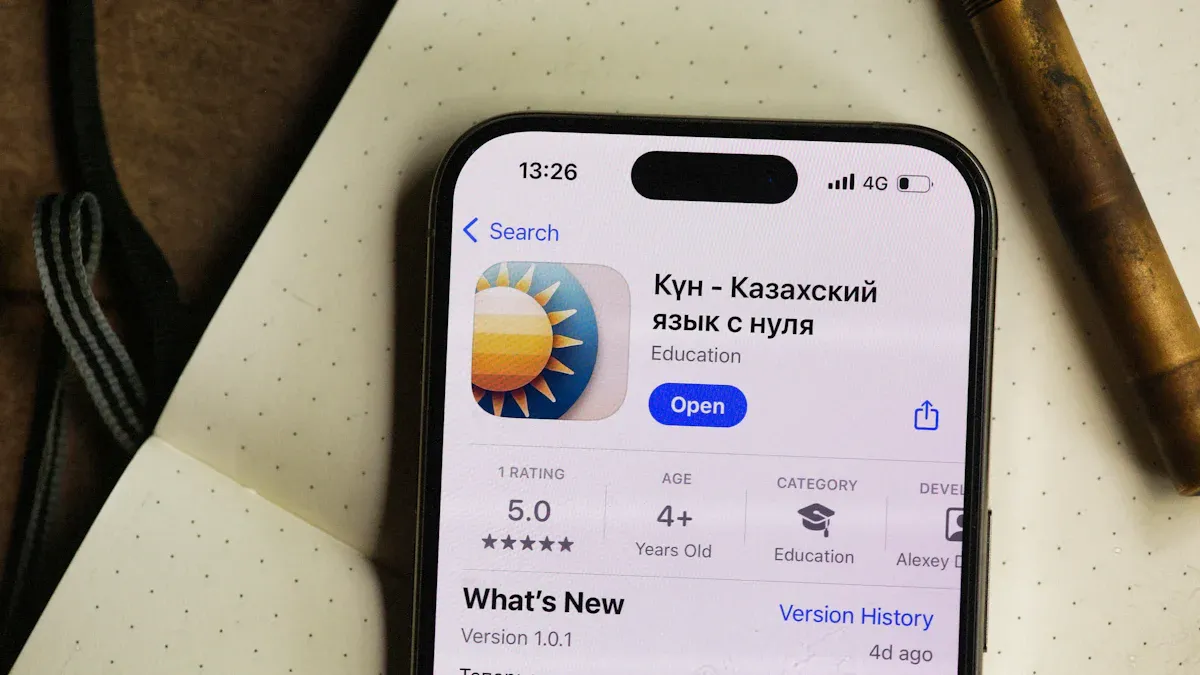
AI education is transforming how you learn and how teachers teach. By 2025, AI in schools may be worth $6 billion, highlighting the rapid growth of AI education. Many students and teachers use AI education tools every day. You can see AI education in action with tools that customize lessons to fit you. AI education can also grade work and provide help anytime. It supports learning at your own pace and assists teachers while improving school operations. Consider using these smart AI education tools to help everyone learn more effectively.
-
73.6% of students and researchers use AI education in school.
-
39.6% say AI education helps them learn a lot.
-
Most users are young, like high school and college students.
Key Takeaways
-
AI makes lessons just for you. It matches your speed and needs. This helps you stay interested and learn faster.
-
AI tutors and helpers give quick answers. They help you anytime. This makes learning easier and more fun.
-
Computers grade work fast. Teachers save time. You get feedback quickly and can fix mistakes to learn better.
-
AI tools help schools find students who need help early. They give support so you can do well in school.
-
AI handles schedules and paperwork. This lets teachers spend more time teaching and helping students.
Personalized Learning
AI Education Platforms
Personalized learning happens in classrooms every day now. AI tools like Carnegie Learning and Duolingo use smart tech. They make lessons just for you. These platforms change lessons based on how you do. If you need more help, you get extra practice. If you learn fast, you move ahead quickly. This way, you get help when you need it.
Carnegie Learning uses AI to help you learn math. You get feedback to fix mistakes and get better. Duolingo helps you learn languages with lessons that change as you learn. The app checks what you know and what you need to work on. You always get lessons that fit you. Almost 100 million people use these learning tools. Personalized learning is very powerful.
Personalized learning keeps you interested in class. You stay excited because lessons match what you know and like.
Benefits for Students and Teachers
Personalized learning has many good points for students. You get lessons made just for you. You can learn at your own speed. Teachers use these tools to see how you are doing. They can find out where you need help. This makes it easier for teachers to help everyone.
Here is a table that shows how personalized learning helps:
|
Institution / Platform |
Improvement Metric |
Numerical Evidence |
|---|---|---|
|
Arizona State University |
Fewer students fail classes |
|
|
Arizona State University |
More students finish courses |
12% more completions |
|
Khan Academy |
Better math skills |
22% more growth |
|
Duolingo |
Remembering words longer |
~34% better memory |
|
Case Western Reserve University |
Better learning in anatomy |
40% better results |
|
Human-AI Collaborative Teaching Models |
Higher student achievement |
15-20% better scores |
|
Stanford University |
Faster learning with personal lessons |
30-40% faster progress |
Look at this chart for more results:
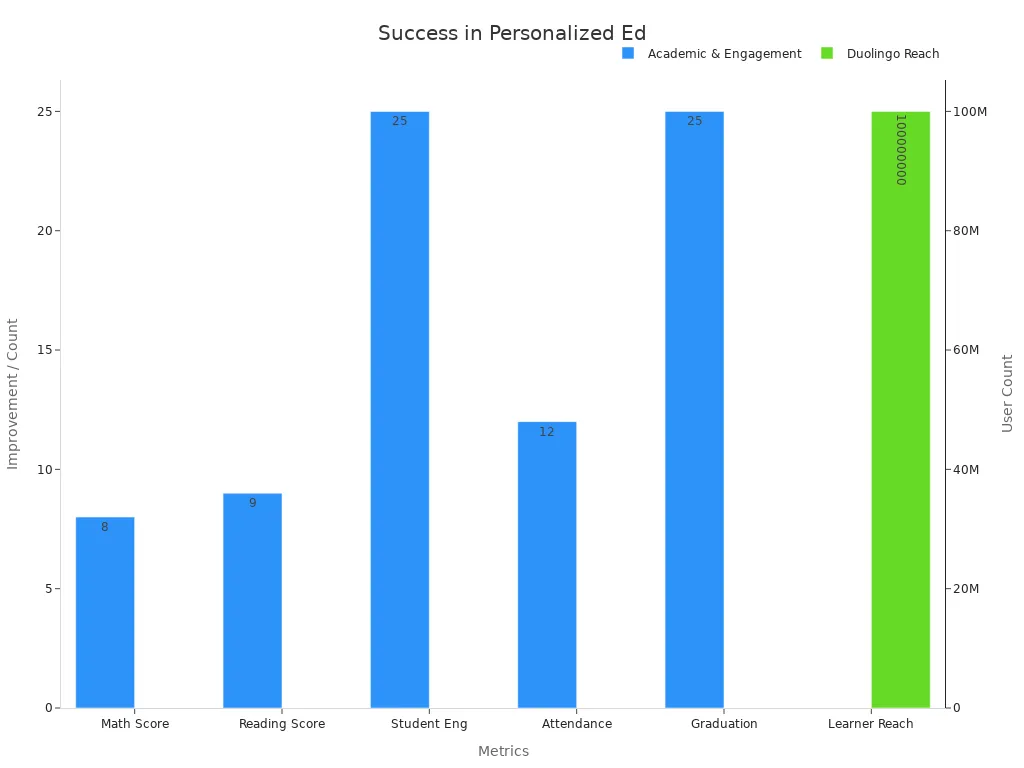
Schools using personal learning see 25% more students paying attention. Attendance goes up by 12%. Some schools have 25% more students graduating after using these tools. Personalized learning helps you stay on track and reach your goals. Teachers spend less time on boring tasks and more time helping you learn.
Intelligent Tutoring
AI in Education Support
AI tutoring tools help you learn in new ways. These tools use smart computers to give you help that fits you. When you use something like Khanmigo, you get hints fast. The tool checks your answers and tells you what you did right or wrong. You do not have to wait for your teacher to check your work. You can learn when you want and get help any time.
Many students like using these AI tutors. It feels like having your own helper. You can ask questions and try new problems. The tool gives you steps to solve them. It uses your answers to pick the next lesson. If you need more help, you get more practice. If you do well, you move ahead faster. This help keeps you working hard and paying attention.
Students say AI tutors make learning easier and more fun.
Student Outcomes
AI tutors help you study better and use your time well. You can see how you are doing and set goals. Studies show these tools can help you get better grades. You also spend less time studying. You get feedback right away, so you stay interested. This helps you learn more in math and science.
Here are some ways AI tutors help you:
-
Help you study and manage your time
-
Raise your grades and test scores
-
Give you feedback right away
-
Change lessons to fit how you learn
-
Support students who need extra help
Look at this table to see how AI tutors work:
|
Key Finding |
Description |
Implication for Effectiveness |
|---|---|---|
|
Student Engagement |
Some students use AI less if it is not in class |
Using AI in class helps more students |
|
Student Experience |
Students like feedback and video help |
Good feedback helps students learn more |
|
Academic Outcomes |
No big test score changes without full use |
Using AI more may help scores later |
|
Deployment Limitations |
Not using AI in lessons limits its help |
Schools should use AI with class lessons |
|
Future Directions |
Adding chatbots and new tools can help more |
More AI tools may help students do better |
AI tutors work best when teachers use them in class. You learn more when AI tools help your teacher, not replace them.
Automated Grading
Efficiency in Assessment
You see big changes in your classroom when you use automated grading and assessment. AI tools can grade essays, multiple-choice tests, and even coding assignments. You get feedback much faster than before. In the past, you might have waited weeks for your teacher to return your work. Now, you can see your results in just a day or two. This quick feedback helps you learn from your mistakes right away.
Many schools use AI to grade thousands of assignments at once. Platforms like Coursera and edX use AI to check answers for large online classes. The University of Michigan’s ECoach system gives you feedback on your writing. You can improve your work before the final grade. Coding platforms like CodeSignal and HackerRank use AI to score your code. You know how you did without waiting for your teacher.
AI grading tools can match the accuracy of human graders. The Automated Student Assessment Prize showed that AI can grade essays as well as teachers.
Here are some ways AI makes assessment more efficient in your classroom:
-
Over 80% of assignments in most classrooms get AI-generated scores.
-
Teachers can assign more writing because AI gives feedback quickly.
Teacher Workload Reduction
You help your teacher save time with AI grading tools. Teachers spend less time grading and more time helping you in the classroom. With automated assessment and feedback, your teacher can focus on teaching and answering your questions. This leads to efficient classroom management.
Teachers report that AI cuts grading time by 80%. Feedback now comes in 1-2 days instead of weeks. One English teacher said, “Students loved getting a grade and feedback so fast, instead of waiting 2–3 weeks.” More teachers say they can give you better, more personal feedback. They also feel less stressed about grading piles of papers.
-
Teachers use AI feedback as a guide to help you improve.
-
57% of teachers find AI feedback clear and helpful.
-
Teachers can manage the classroom better and spend more time with students.
Automated grading and assessment lets you and your teacher focus on learning. Your classroom becomes a place where you get help faster and reach your goals sooner.
Language Learning AI

Adaptive Language Tools
AI tools help you learn new languages in a smart way. Duolingo uses AI called BirdBrain to make lessons for you. Over 300 million people use Duolingo. The app changes lessons as you get better. If you have trouble with a word, you get more practice. If you do well, you get harder lessons. This keeps you interested and helps you learn faster.
Duolingo Max is the paid version. It uses GPT-4 for cool features. You can use Explain My Answer and Roleplay. These let you practice talking and get feedback fast. Many people say these tools make learning fun. They also help you remember words longer. You can talk to a virtual friend or play games. These games make learning feel like fun.
Tests show Duolingo’s new AI helps students learn more. In 2022, they started using BirdBrain V2. It works better for students. Reviews say that feedback and custom lessons help you learn faster.
Accessibility Features
AI language tools help more students join lessons. Speech recognition lets you practice talking and get feedback. If you cannot hear or see well, AI can help. It gives you captions, Braille, and reads text out loud. These tools help everyone join in.
Here are ways AI makes learning easier:
-
Object detection and OCR help students who cannot see well.
-
Adaptive systems make special lessons for each student.
-
Some AI uses sight, sound, and touch to help you learn.
|
Platform / Institution |
Metric / Outcome |
Value / Percentage |
|---|---|---|
|
Brainly |
More students use it |
|
|
|
Students are happy |
90% |
|
Squirrel AI (Adaptive Learning) |
Students get better test scores in 6 months |
70% |
|
|
Fewer learning gaps |
25% |
|
AI chatbots |
Right answers for students |
|
|
Adaptive learning programs |
Higher test scores |
62% |
These tools help students everywhere in the world:
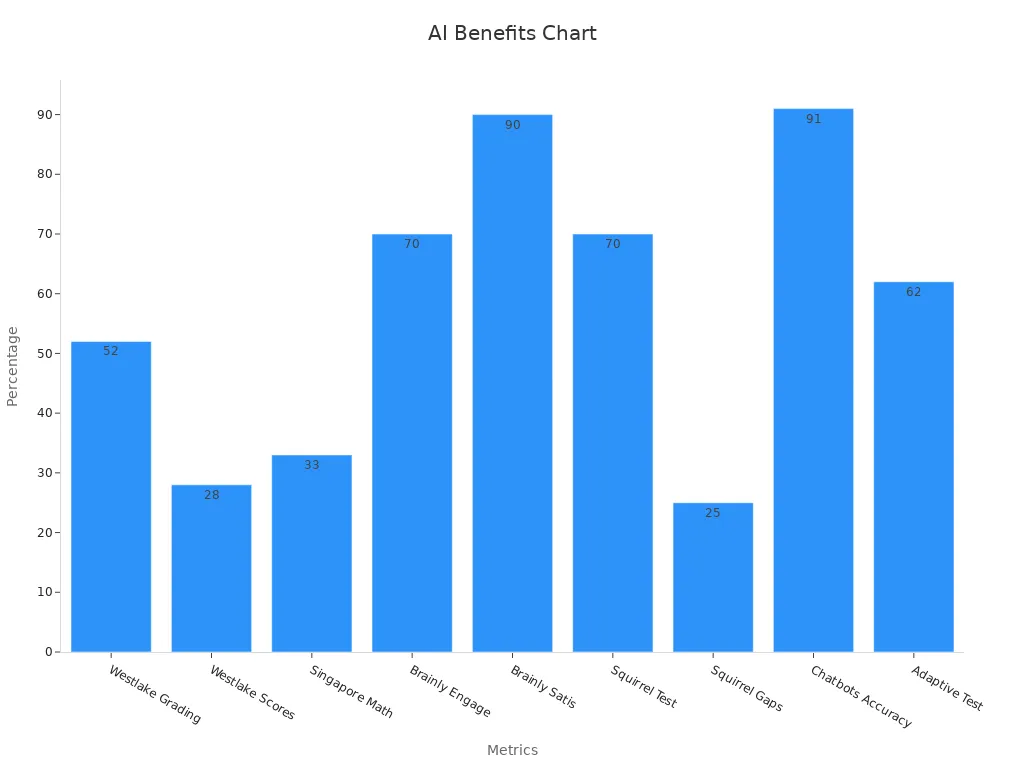
AI language learning gives you new ways to learn. You get lessons that fit you and tools to help you do well.
Predictive Analytics
Helping Students Succeed
Predictive analytics helps schools support students better. AI tools look at data like grades, attendance, and online activity. They find students who might need extra help. For example, Georgia State University uses over 800 risk factors to spot struggling students. This helped them raise graduation rates by 22%.
AI also checks personal details, like if you're the first in your family to attend college or have money problems. At Austin Peay State University, the Degree Compass system suggests classes where students are likely to do well. It gives advice based on your needs, not general tips.
Here’s how AI finds students needing help:
-
Tracks grades and attendance
-
Notices unfinished assignments
-
Spots low quiz scores or dropped classes
-
Watches for signs of stress or loneliness
-
Monitors class participation
AI uses patterns in this data to offer help before problems grow.
Acting Early to Help
When AI sees a problem, schools act quickly. Early warning systems alert teachers and advisors. They can offer tutoring, mental health support, or extra lessons. The University of Arizona uses AI to track online learning habits. This raised student retention by 3.5% in three years.
Schools using these systems see big improvements. Check the table below for results:
|
Metric |
Statistic |
Context |
|---|---|---|
|
Dropout rate reduction |
23% decrease |
With AI early-warning systems |
|
Course completion rate increase |
68% to 87% |
After AI engagement tools in online learning |
|
Retention increase |
14% increase |
With comprehensive AI platforms |
|
Pass rate improvement |
18% increase |
Arizona State University math with AI |
|
Withdrawal rate reduction |
22% decrease |
Arizona State University AI initiative |
|
Advanced course continuation |
31% increase |
Arizona State University math with AI |
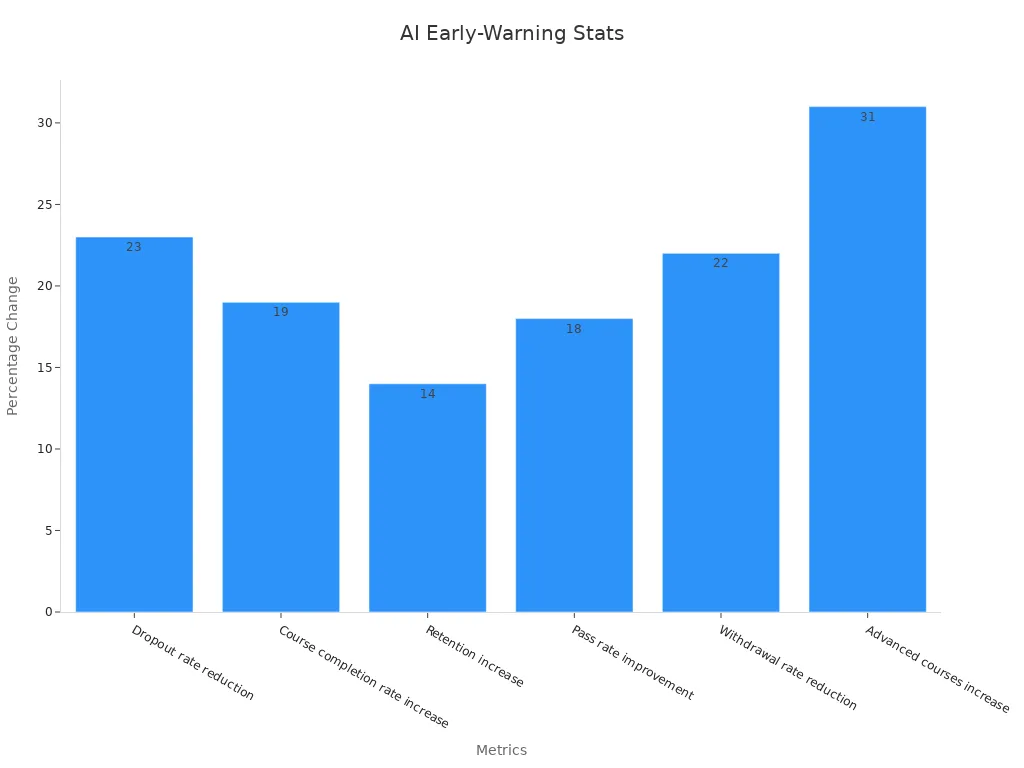
AI tools give reminders, advice, and support when you need it. They help you stay on track and finish your courses successfully.
Virtual Assistants
AI Chatbots in Education
Virtual assistants are common in schools now. They help you get answers fast. When you use online classes, chatbots answer your questions. You can ask about homework or class topics. You do not need to wait for your teacher. At Georgia Tech, a chatbot answered in under 40 seconds. Before, students waited over 38 hours for help. Fast answers stop you from feeling stuck. You finish your work on time.
Many schools use chatbots for class help. These helpers give hints and explain lessons. They guide you through hard problems. You can ask questions any time, day or night. A study with 819 college students showed most liked chatbots. Students enjoy getting personal help and finding answers fast. Some miss talking to real people. Still, most say chatbots make learning easier.
Virtual assistants let you learn at your own speed. They give you help when you need it most.
24/7 Student Support
Virtual assistants do more than answer homework. They help with school tasks like signing up for classes. You can find library books or check your grades. Chatbots remind you about deadlines and help fill out forms. The University of Galway uses Cara, a virtual helper. Cara answers many types of questions, even private ones. Cara learns from feedback and gets better each week.
Schools use virtual helpers to save time and money. Staff spend less time on easy questions. They help students in person more. Georgia State University uses Pounce, a chatbot. Pounce sends reminders and surveys to new students. This helps more students join and stay in school. Virtual helpers are useful when there are too many students for one teacher. New tech makes these helpers smarter every year.
-
Virtual assistants make services better and help staff.
-
They answer class and office questions.
-
You get help all day and night, so you are never alone.
You can trust chatbots and helpers to make school life easier and more connected.
Content Creation AI
Generative Tools for Teachers
Generative AI makes teaching easier and more creative. These tools help you quickly make lesson plans, quizzes, and activities. For example, ChatGPT can create stories or coding tasks that match your lessons. You don’t need to spend hours searching for ideas. AI can suggest new activities and writing styles for your students.
Here’s how generative AI helps teachers:
-
It handles boring tasks, so you can focus on teaching.
-
You get quick ideas for assignments and class activities.
-
AI summarizes articles and rewrites goals to make them clear.
-
Tools like ChatGPT create fun quizzes and practice sheets.
These tools make classrooms more exciting and efficient. Many teachers say AI reduces stress and boosts creativity when planning lessons.
Personalized Learning Materials
Generative AI helps you create lessons for every student’s level. You can give harder problems to advanced students and extra help to those struggling. In one study, 110 students used lessons made by ChatGPT-3.5 and 4. Results showed 66.4% of students enjoyed the lessons, and 57.2% felt they learned a lot. Advanced students reported even better results.
|
Metric |
Overall (%) |
Advanced Group (%) |
Intermediate Group (%) |
Basic Group (%) |
|---|---|---|---|---|
|
Students enjoying lessons |
66.4 |
N/A |
N/A |
N/A |
|
Students feeling they learned a lot |
57.2 |
78.8 |
54.2 |
42.9 |
|
Students learning little or nothing |
13.6 (combined) |
6.0 |
14.3 |
19.0 |
Check the chart below to see how students at different levels felt about their lessons:

With AI tools, you can create lessons that fit each student’s needs. This keeps everyone interested and learning more. Virtual tools also make it easy to update lessons. You can help more students succeed with materials designed just for them.
Accessibility Solutions
Inclusive AI Education
AI helps make classrooms better for everyone. Some tools change lessons to fit how you learn. Students with special needs get extra help from these tools. Chatbots and smart tutors let you learn at your own pace. If you need more practice, you get it. If you need feedback, you get it fast.
Text-to-speech apps read words out loud to you. Self-check tools help you stay on task. These tools keep you focused and help you want to learn. Teachers feel more sure when they use these tools. Students with disabilities join in more and learn better. AI games and smart speakers make lessons fun. You get more chances to do well in school with these tools.
|
Study / Author(s) |
Type of Evidence |
Key Findings |
|---|---|---|
|
Arslan-Ari & Baser (2023) |
Survey of special education teachers |
Training in assistive technology improves classroom support for students. |
|
Nordstrom et al. (2019) |
6-week intervention |
Text-to-speech apps boost motivation and accessibility for reading challenges. |
|
Ioana-Alexandra et al. (2021) |
Review and demonstration |
AI chatbots and smart speakers help students with visual and learning needs. |
AI tools give you more control over your learning. They help you reach your goals.
Adaptive Technologies
Adaptive tech makes learning easier for everyone. Real-time captions show words as people talk in videos. If you have trouble hearing, captions help you follow along. Many students, even those learning English, say captions help them understand. A study with 2,000 students showed most liked using captions. Captions made it easier to join class talks.
-
Real-time captions work with many voices and accents.
-
AI captions meet school rules for helping all students.
-
Caption tools are right 99% of the time, so you can trust them.
-
These tools also help in jobs like healthcare and banking by making info clear.
You get help from tools that change to fit you. These tools keep you interested and help you learn at your own speed. You can join every lesson and take part in class.
Administrative Automation
AI in School Operations
AI helps schools run better. It handles jobs like making class schedules and tracking who is in class. AI also helps with signing up for classes. These jobs finish faster and with fewer mistakes. You get your schedule or updates quickly. AI can send alerts if you miss class. Teachers and parents know who is there. This keeps everyone organized.
AI checks how many teachers and classrooms are needed. It looks at staff schedules and school budgets. The system can tell when more supplies or teachers are needed. AI keeps student records and reports safe. Staff do less paperwork and have more time to help students.
AI lets you focus on learning. The system takes care of the details.
Streamlined Processes
AI makes school work easier and faster. You save time because tasks like signing up and paperwork go quicker. Staff spend less time on forms and more time with students. Schools say AI cuts costs by 32%. Signing up for classes is 41% faster. Paperwork time drops by 52%. AI chatbots answer questions, so staff spend 63% less time on easy tasks.
|
Performance Metric |
Improvement / Time Savings |
|---|---|
|
Lower administrative costs |
32% less money spent |
|
Faster enrollment |
41% quicker |
|
Better scheduling |
37% more efficient |
|
Less time on paperwork |
52% less time |
|
Staff time saved with chatbots |
63% less time spent |
|
More resources for teaching |
29% of savings used for classes |
See more benefits in this chart:
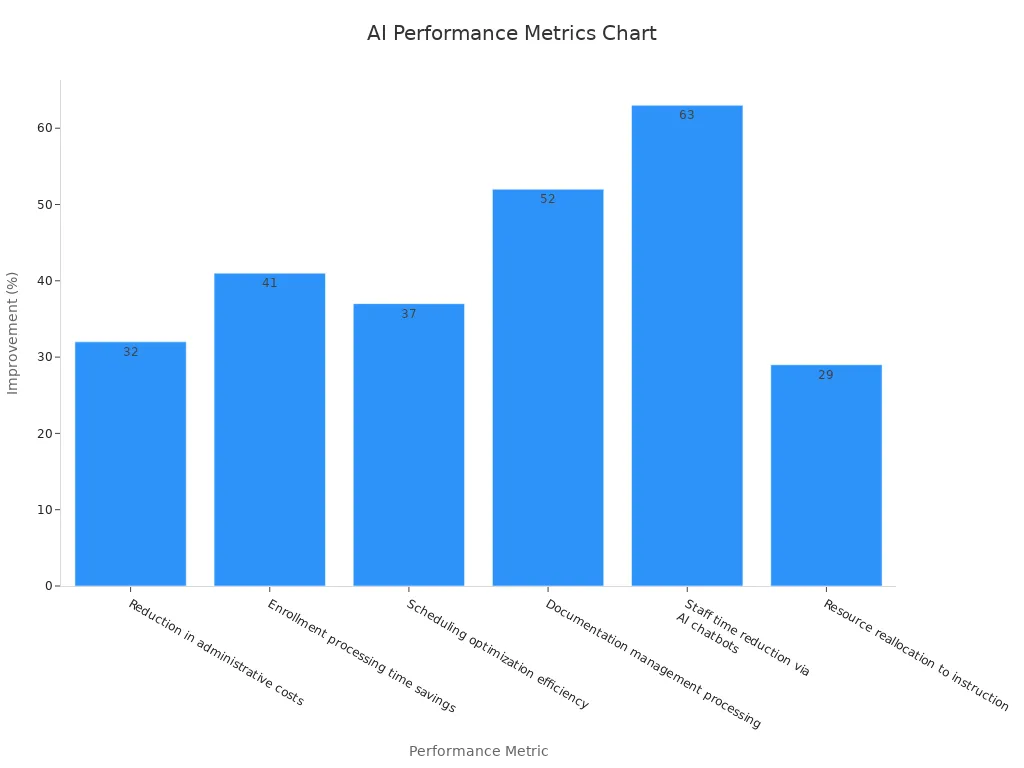
Western State University saved $380,000 in one year with AI. Lakeside School District stopped 120 mistakes each year using AI. Many schools say AI cuts management time by 80%. Fewer staff leave their jobs, and more substitutes fill in. AI helps track absences and plan budgets. This makes school management smarter and more reliable.
Academic Integrity Tools
AI Plagiarism Detection
It is important to do your own work. AI tools help check if students copy or use AI to write. Many schools use these tools now. In 2023-24, 68% of teachers used AI checkers. Most students and teachers—87%—think these tools stop cheating.
AI scans essays, reports, and homework for copied parts. The tools compare your writing to many things online. They also check if a computer wrote your work. Turnitin, Originality.ai, and GPTZero look for copied or AI-made text. These tools help teachers find problems early and keep things fair.
AI checkers teach you why honesty and hard work matter.
Maintaining Standards
Using these tools helps keep school rules strong. AI checkers find copied work and AI-written text. Some tools work better than others. Originality.ai found all AI and changed text in one test. GPTZero and ZeroGPT also work well, but not as well as Originality.ai. Turnitin does a good job in many schools.
Here is a table showing how well the tools work:
|
AI Detection Tool |
Accuracy Rate (%) |
AUC (%) |
Notes |
|---|---|---|---|
|
Originality.ai |
97.09 |
97.6 |
Did better than GPTZero by over 30% in one study; found all GPT-4 and GPT-3.5 text |
|
GPTZero |
63.77 |
N/A |
Tested on Human and AI Text Database (AH&AITD) |
|
ZeroGPT |
96 (ChatGPT), 88 (AI-rephrased) |
N/A |
Uses DeepAnalyse; second best in one study |
|
Originality.ai |
100 (ChatGPT and AI-rephrased) |
N/A |
Found all AI and changed text in one test |
|
Turnitin |
N/A |
N/A |
Did very well; Originality.ai found all GPT-4 and GPT-3.5 text in the same study |
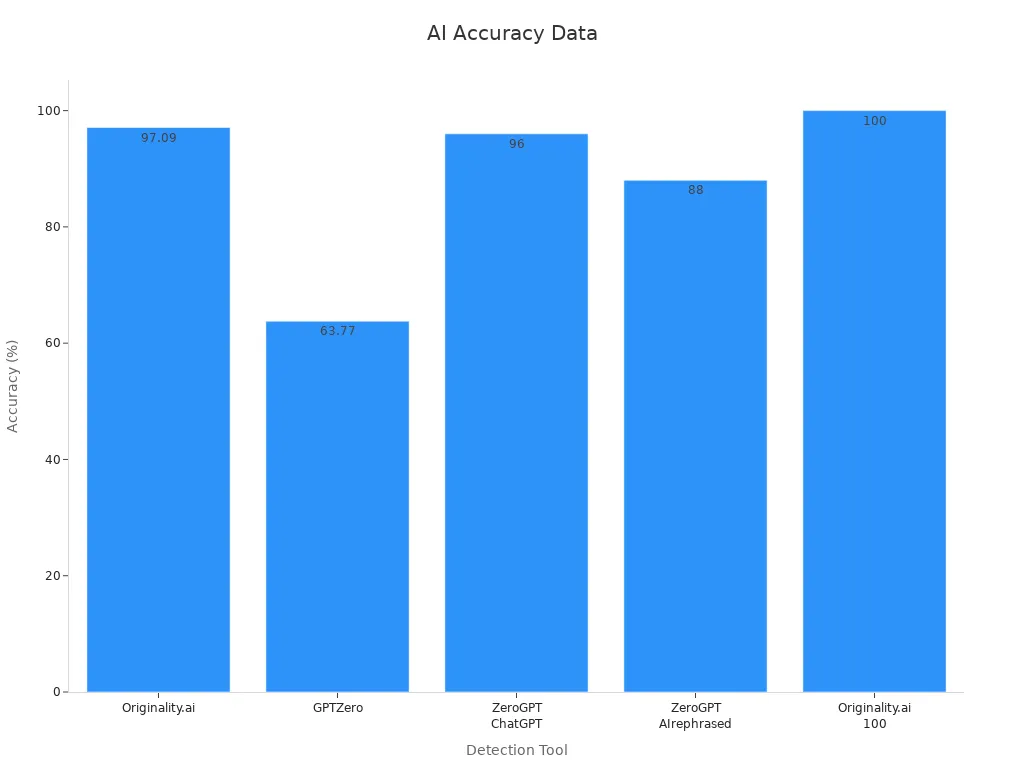
These tools are not perfect. Sometimes, they miss AI writing or call real writing fake. Experts say to use more than one way to check for cheating. Teachers can give different tasks, ask for drafts, and watch for changes in writing. AI works best when teachers use smart tools and good teaching together.
Benefits and Challenges
Key Advantages
You see many benefits when you use AI in your classroom. AI gives you personalized lessons that match your needs. You learn at your own speed, and your teacher can help you more. Teachers use AI to spot where you need extra support. This makes your classroom a place where everyone can do their best. Schools use AI to save time on tasks like grading and scheduling. Staff spend more time helping students and less time on paperwork. AI tools help students with special needs join every classroom activity. You get feedback quickly, which helps you fix mistakes and improve. AI also helps teachers create personalized materials for every student. This keeps your classroom active and focused on learning.
AI brings new ways to learn and helps everyone in the classroom reach their goals.
Addressing Concerns
You must also think about the challenges of using AI in your classroom. Privacy is a big concern. AI collects a lot of student data, so schools need strong rules to keep your information safe. Sometimes, AI can show bias if it learns from unfair data. This can lead to unfair grades or decisions in your classroom. Some students and teachers worry about losing control over learning. Experts say that federated learning can help protect privacy by keeping data on your device. Still, it is hard to make sure AI always gives you a truly personalized experience. Teachers and students need to learn about AI ethics. Programs like “AI and Ethics” from MIT Media Lab help you understand bias and privacy. Schools need clear rules and training to use AI safely in the classroom. You should always ask questions about how AI works and how it uses your data. Building trust in AI means making sure everyone in the classroom knows how decisions happen and who is responsible.
You see how ai education changes classrooms and helps you learn in new ways. Schools and teachers use smart tools to give you lessons that fit your needs. Experts say that long-term studies are still needed to show how AI will shape learning over many years. Good data practices help schools track progress and build a strong future. Stay curious about new tools and use them wisely. Explore real-life examples and keep learning about safe and fair AI use.
FAQ
What is AI in education?
AI in education means you use smart computer programs to help you learn. These tools can give you lessons, grade your work, and answer your questions. You get help that fits your needs and learning style.
How does AI help teachers?
AI helps teachers by grading assignments, tracking your progress, and creating lesson plans. Teachers spend less time on paperwork. They can focus more on helping you learn and answering your questions.
Can AI replace teachers?
AI cannot replace teachers. You still need teachers to guide you, explain ideas, and support you. AI works best when it helps teachers and students work together.
Is my data safe with AI tools?
Most schools use strong rules to keep your data safe. You should always ask how your school protects your information. If you have questions, talk to your teacher or school staff.
What are some examples of AI tools I might use?
You might use Duolingo for language learning, Khan Academy for math help, or Turnitin to check your writing. Many schools use chatbots to answer your questions or help you sign up for classes.
